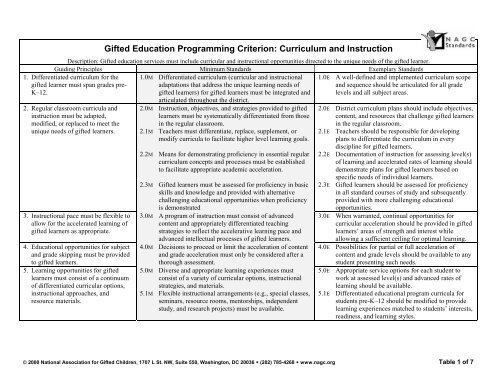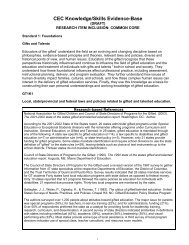Pre-K–Grade 12 Gifted Program Standards - NAGC
Pre-K–Grade 12 Gifted Program Standards - NAGC
Pre-K–Grade 12 Gifted Program Standards - NAGC
Create successful ePaper yourself
Turn your PDF publications into a flip-book with our unique Google optimized e-Paper software.
<strong>Gifted</strong> Education <strong>Program</strong>ming Criterion: Curriculum and Instruction<br />
Description: <strong>Gifted</strong> education services must include curricular and instructional opportunities directed to the unique needs of the gifted learner.<br />
Guiding Principles Minimum <strong>Standards</strong> Exemplary <strong>Standards</strong><br />
1. Differentiated curriculum for the 1.0M Differentiated curriculum (curricular and instructional 1.0E A well-defined and implemented curriculum scope<br />
gifted learner must span grades pre- adaptations that address the unique learning needs of<br />
and sequence should be articulated for all grade<br />
K–<strong>12</strong>.<br />
gifted learners) for gifted learners must be integrated and<br />
articulated throughout the district.<br />
levels and all subject areas.<br />
2. Regular classroom curricula and 2.0M Instruction, objectives, and strategies provided to gifted 2.0E District curriculum plans should include objectives,<br />
instruction must be adapted,<br />
learners must be systematically differentiated from those content, and resources that challenge gifted learners<br />
modified, or replaced to meet the<br />
in the regular classroom.<br />
in the regular classroom.<br />
unique needs of gifted learners. 2.1M Teachers must differentiate, replace, supplement, or 2.1E Teachers should be responsible for developing<br />
modify curricula to facilitate higher level learning goals. plans to differentiate the curriculum in every<br />
discipline for gifted learners.<br />
2.2M Means for demonstrating proficiency in essential regular 2.2E Documentation of instruction for assessing level(s)<br />
curriculum concepts and processes must be established of learning and accelerated rates of learning should<br />
to facilitate appropriate academic acceleration.<br />
demonstrate plans for gifted learners based on<br />
specific needs of individual learners.<br />
2.3M <strong>Gifted</strong> learners must be assessed for proficiency in basic 2.3E <strong>Gifted</strong> learners should be assessed for proficiency<br />
skills and knowledge and provided with alternative<br />
in all standard courses of study and subsequently<br />
challenging educational opportunities when proficiency provided with more challenging educational<br />
is demonstrated<br />
opportunities.<br />
3. Instructional pace must be flexible to 3.0M A program of instruction must consist of advanced 3.0E When warranted, continual opportunities for<br />
allow for the accelerated learning of content and appropriately differentiated teaching<br />
curricular acceleration should be provided in gifted<br />
gifted learners as appropriate.<br />
strategies to reflect the accelerative learning pace and<br />
learners’ areas of strength and interest while<br />
advanced intellectual processes of gifted learners.<br />
allowing a sufficient ceiling for optimal learning.<br />
4. Educational opportunities for subject 4.0M Decisions to proceed or limit the acceleration of content 4.0E Possibilities for partial or full acceleration of<br />
and grade skipping must be provided and grade acceleration must only be considered after a content and grade levels should be available to any<br />
to gifted learners.<br />
thorough assessment.<br />
student presenting such needs.<br />
5. Learning opportunities for gifted 5.0M Diverse and appropriate learning experiences must 5.0E Appropriate service options for each student to<br />
learners must consist of a continuum consist of a variety of curricular options, instructional<br />
work at assessed level(s) and advanced rates of<br />
of differentiated curricular options,<br />
strategies, and materials.<br />
learning should be available.<br />
instructional approaches, and 5.1M Flexible instructional arrangements (e.g., special classes, 5.1E Differentiated educational program curricula for<br />
resource materials.<br />
seminars, resource rooms, mentorships, independent<br />
students pre-K–<strong>12</strong> should be modified to provide<br />
study, and research projects) must be available.<br />
learning experiences matched to students’ interests,<br />
readiness, and learning styles.<br />
© 2000 National Association for <strong>Gifted</strong> Children, 1707 L St. NW, Suite 550, Washington, DC 20036 (202) 785-4268 www.nagc.org Table 1 of 7

















